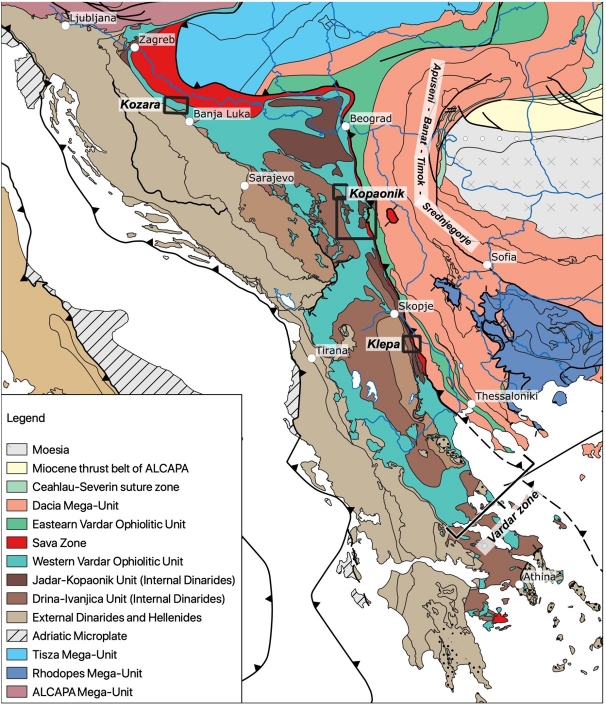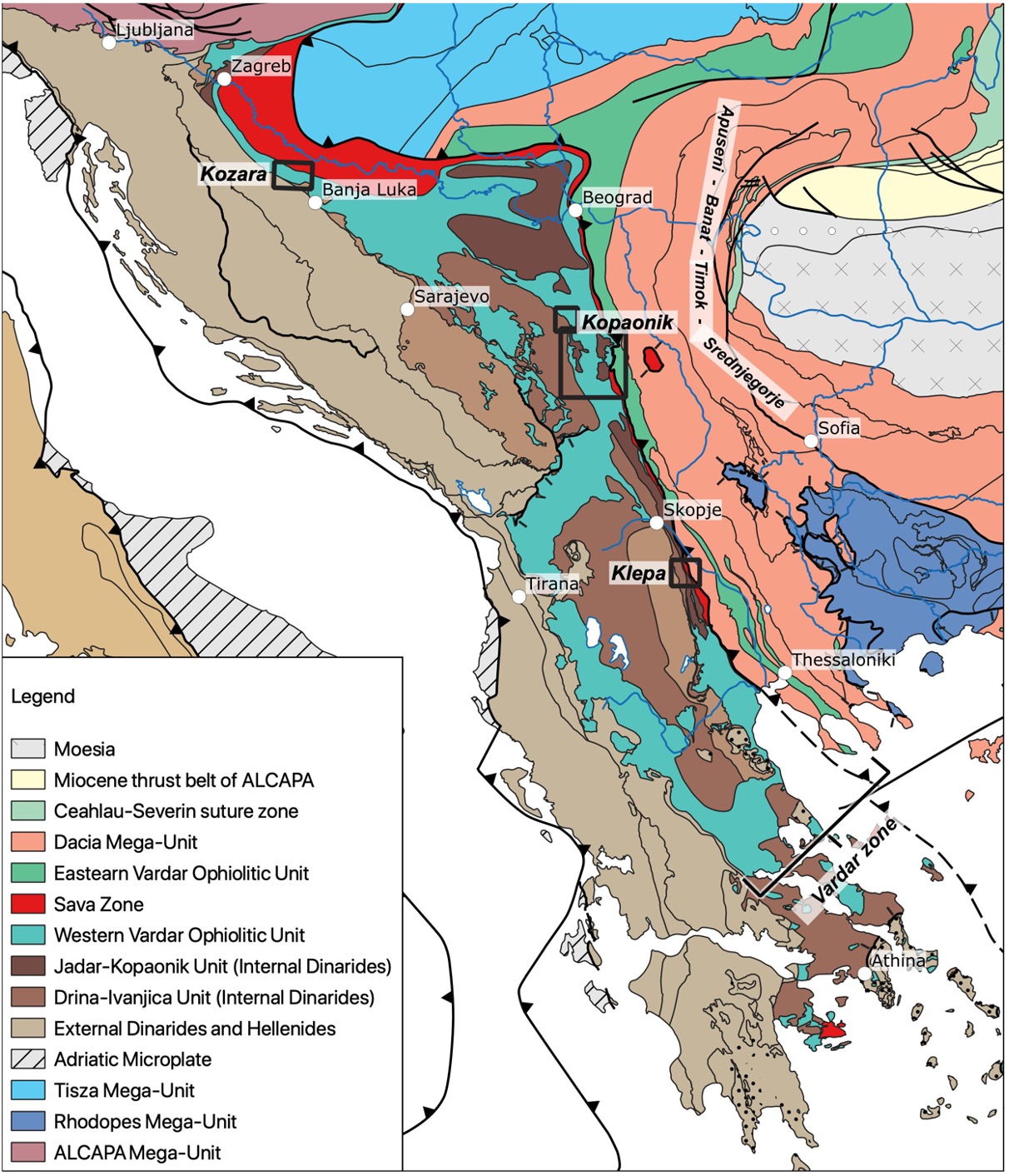

The complex geodynamic evolution of the northernmost Neotethys is the subject of a long-living controversy. The most perplexing issues are related to the waning stage(s) of Tethyan ocean(s) in the Balkans and the timing of the Europe-Adria collision. Some authors consider the Europe-Adria collision to have occurred in the Late Jurassic, whereas others envisage that have happened at the end of the Cretaceous along the Sava Zone. The second model assumes the Cretaceous Sava Ocean contains a relic of the youngest Tethyan oceanic realm left behind after the major convergence in the Jurassic.
RECON TETHYS will study magmatic, sedimentary and basement formations within the Sava Zone, to constrain the timing, origin, geodynamic environment and life span of the alleged Cretaceous Sava Ocean.
The results of this study will have large consequences on our understanding of the Mesozoic development of this part of European continent, and may lead to a complete geodynamic redefinition of the history of the northern branch of Neotethys.
RECON TETHYS will study magmatic, sedimentary and basement formations within the Sava Zone, to constrain the timing, origin, geodynamic environment and life span of the alleged Cretaceous Sava Ocean.
The results of this study will have large consequences on our understanding of the Mesozoic development of this part of European continent, and may lead to a complete geodynamic redefinition of the history of the northern branch of Neotethys.
 Tectonics units of the central Balkans after Schmid et al. (2020)
Tectonics units of the central Balkans after Schmid et al. (2020)
 Tectonics units of the central Balkans after Schmid et al. (2020)
Tectonics units of the central Balkans after Schmid et al. (2020)
Natural laboratories
Klepa Mts.
The Klepa Massif represents a 5-6 km NNW-SSE and 1-2 km WSW-ENE extending block with a height of 1150 m a.s.l. and is a visible landmark in the municipality of Gradsko (central N. Macedonia). The sedimentary sequences include Upper Cretaceous mixed siliciclastic-carbonate clastics comprising impure shales, sheared limestones (Scaglia Rossa), carbonates, sandstones and conglomerates. The Late Cretaceous volcanics (82 Ma, Ar-Ar age; Prelević et al., 2017) include pillow basalts, basaltic sheet flows, columnar lava, hyaloclastite, basaltic dykes and microgabbros, which possess clear geochemical signatures (trace elements, Sr, Nd, Pb isotopes) of within-plate basalts (Prelević et al., 2017).
The Upper Cretaceous sedimentary and volcanic sequences rest upon Triassic and Jurassic units, represented by a tectonic serpentinite mélange (Jurassic Western Vardar ophiolite) and underlying platform carbonates. The oldest basement formations are marble, limestone and micaschists of the Paleozoic Veles Series formation (Grubić, 1974), displaying variable thicknesses of 1–70 m and a general N-S strike. The Veles Series represents a westernmost margin of the Eurasian continent during the Mesozoic closure of the Neotethyan ocean(s), which experienced four major stages of ductile deformation including Variscan, early Permian, Middle Triassic and Early Jurassic ones (Antić et al., 2016a, b, 2017).
Previous data allowed a working tectonic model to be recently proposed for the whole Klepa tectono-magmatic stage during which the deformation and magmatism have been generated in Klepa (Köpping et al., 2019).
Kopaonik Mts.
The area of the Kopaonik Mts. in southern Serbia is dominated by a large antiformal structure that stretches generally in the N – S direction for about 30 kilometres. The core of this antiformal structure is made of Oligocene granitoids, while its limbs consist of a sedimentary sequence belonging to the Sava Zone and Jurassic ophiolites and ophiolitic mélange of the Western Vardar Ophiolitic Unit, as well as of older, multiply deformed rocks of the Kopaonik Metamorphic Series, which represent parts of the Adriatic margin of Gondwanan continent.
The oldest basement formations include the Kopaonik Metamorphic Series that is part of the Jadar – Kopaonik thrust sheet, which represents the most internal tectonic unit of the Internal Dinaride unit of the Adriatic margin of Gondwanan affinity. It is composed of Upper Paleozoic terrigenous sediments overlain by Lower Triassic siliciclastics and limestones and Anisian shallow-water carbonates (Schefer et al. 2010, Zelić et al. 2010). The youngest sediments overlying the Kopaonik formation are red hemipelagic limestones and radiolarites of probably Middle-Late Jurassic age (Schefer et al. 2010), which suggests that deep-pelagic conditions preceded the obduction of the Western Vardar Ophiolitic Unit in Late Jurassic time.
The Sava Zone sedimentary rocks are underlain by an ophiolite-bearing tectonic-sedimentary mélange of considerable thickness representing the basis of the Jurassic Western Vardar Ophiolitic Unit. The mélange is thrust on top of the Kopaonik Metamorphic Series. Schefer (2010) reports an amphibolite-facies overprint of these rocks together with a greenschist-facies retrogression, arguing that this part of the Western Vardar Ophiolitic Unit was subjected to a considerable post-obduction (Cretaceous?) regional metamorphic overprint.
The Upper Cretaceous sediments of the Sava Zone, contain large olistoliths, including ophiolites and metamorphic rocks. The basis is formed by a calcitic sedimentary breccia containing ophiolitic detritus and clasts and blocks of basement rocks. Upper Cretaceous Scaglia Rossa red limestones are typical for this unit. Olistoliths ranging in size from the m – dm scale are incorporated into the Upper Cretaceous sediments.
The Oligocene (31.77 – 30.70 Ma, Schefer et al. 2011) I-type biotite- to hornblende-biotite metaluminous granitoids of the Kopaonik volcano-plutonic province (Mladenović et al. 2015) intrudes all aforementioned units. It is accompanied by large sheets of acid to intermediate volcanic and volcaniclastic rocks. The granitoids were exhumed during the Middle Miocene extensional tectonic event (Schefer et al. 2011; Mladenović et al. 2015) along low-angle normal faults.
The previous interpretation based only on the field studies, indicates that a more detailed and combined structural and petrological study will fully reveal the timing of every single deformation episode during the Upper-Cretaceous tectono-magmatic evolution.
Kozara Mts.
Another important inselberg within the Sava Zone is the Kozara Mts. in the northernmost Bosnia and Herzegovina. This is the very location where the model about the existence of the Late Cretaceous Sava Ocean has been established based on the interpretation that the Cretaceous pillow basaltic lavas and sheeted dykes from the northern Kozara Mts. represent part of dismembered ophiolites (Cvetković et al., 2014, Karamata et al., 2005).
The Kozara Mts. is a ~15 km long and ~5 km wide inselberg that extends ENE—WSW, starting from Gornji Podgradci to Maglajci in the east and the west, respectively. The southern part of the massif consists of pillowed basalts and gabbro-diabase rock series belonging to Jurassic West Vardar ophiolites (Schmid et al. 2008, Ustaszewski et al., 2009).
The northern part of the Kozara Mts. is separated from the Upper Jurassic ophiolites of south Kozara by a major N-dipping thrust (Ustaszewski et al., 2009). In contrast to the south Kozara ophiolites, the northern Kozara is represented by Upper Cretaceous bimodal magmatic formation covered by continent-derived sediments. It consists of basaltic pillow and dyke series that are associated with large masses of rhyolitic lavas; ultramafic rocks are lacking. The available geochemical data demonstrate that the rocks of the basic suite of north Kozara show relatively flat to moderately light-REE enriched patterns with no negative Eu-anomaly and Zr/Nb around 15 (Cvetković et al., 2014). These geochemical characteristics are different from those shown by other Jurassic Balkan ophiolites, and is, therefore, interpreted as representing enriched mid-ocean ridge basalts formed within an anomalous ridge setting similar to present-day Iceland (Cvetković et al., 2014). The lavas of the felsic suite exhibit steeper REE patterns and have distinctively more pronounced Eu- and Sr- negative anomalies. Based on these data, Cvetković et al. (2014) postulated that the felsic suite most probably originated via partial melting of gabbro from the lower oceanic crust.
The previous studies revealed that the basaltic lavas are unusually enriched compared to Jurassic ophiolitic basalts from the Balkans. Moreover, the isotopic data are not available, which would be especially useful to trace the melting source of the felsic members of the bimodal magmatic formation. Finally, the microstructural study of the basement rocks, coupled with the age determination will be of high importance, similarly like in other natural laboratories.